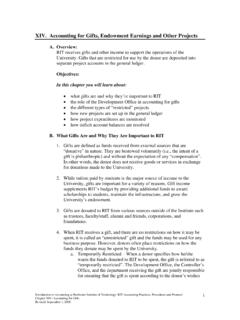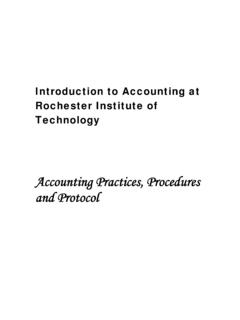Transcription of Areas by Integration - Rochester Institute of Technology
1 Page 1 of 9 1. area under a curve region bounded by the given function, vertical lines and the x axis. 2. area under a curve region bounded by the given function, horizontal lines and the y axis. 3. area between curves defined by two given functions. 1. area under a curve region bounded by the given function, vertical lines and the x axis. If f(x) is a continuous and nonnegative function of x on the closed interval [a, b], then the area of the region bounded by the graph of f, the x-axis and the vertical lines x=a and x=b is given by: badxxfArea)( When calculating the area under a curve f(x), follow the steps below: 1. Sketch the area . 2. Determine the boundaries a and b, 3. Set up the definite integral, 4. Integrate. Ex. 1. Find the area in the first quadrant bounded by 24)(xxxf and the x-axis. Graph: To find the boundaries, determine the x-intercepts: 040)(2 xxxf 0)4( xx 0 xor 0)4( x so0 x and4 x Therefore the boundaries are0 a and4 b Areas by Integration A Page 2 of 9 Set up the integral: 402)4()(dxxxdxxfAba Solve: 323240324032402031024314231231214)4(xxxx dxxx 33206431162 The area in the first quadrant under the curve 24)(xxxf is equal to 332square units Ex.
2 2. Find the area bounded by the following curves: ,42 xy,0 y,4 x Graph: Finding the boundaries: ,42 xy and 0 y implies 042 xso 022 xx 2 x or 2 x From the graph we see that 2 xis our boundary at a. The value2 x is a solution to the equation above but it is not bounding the area . (Here s why the graph is an important tool to help us determine correct results. Don t skip this step!) The other boundary value is given by the equation of the vertical line ,4 x Boundaries are: ,2 aand ,4 b Set up the integral: 422)4()(dxxdxxfAba Solve: 2423144431431)4(33423422xxdxx 33283568381636483816364 The area bounded by the curves ,42 xy,0 y,4 xis equal to 332square units. b a A Page 3 of 9 2. area under a curve given function, region bounded by the horizontal lines and the y axis. In certain problems it is easier to rewrite the function in terms of y and calculate the area using horizontal elements. In this case the formula for the area would be: dcdyygArea When calculating the area under a curve, or in this case to the left of the curve g(y), follow the steps below: 1.
3 Sketch the area . 2. Determine the boundaries c and d, 3. Set up the definite integral, 4. Integrate. Ex. 3. Find the first quadrant area bounded by the following curves: 22 xy,4 yand0 x . There are two ways to solve this problem: we can calculate the area between two functions4 y and 22 xy using the vertical elements and integrate with respect to x, or we can use the horizontal elements and calculate the area between the y-axis and the function22 xyintegrating the functions with respect to y. We will solve it using the second approach by considering horizontal elements and the function in terms of y. The formula we will use is: dcdyygArea , so we need to determine the boundary values c and d first. The boundary value d corresponds to the horizontal line4 y. To calculate c, we need to locate the y-intercepts. Therefore set0 x and solve the equation22 xy for y; hence2 y. So the boundaries are vertical elements d c A Typical rectangle (with width of dx) horizontal elements Typical rectangle (with width of dy) Page 4 of 9 Now we need to find our g(y).
4 That is easily done by solving 22 xy for x. 22222 yxyxxy We will ignore the negative radical, since our area is in the first quadrant. Now let s set up the integral: dyyA 422 Solve the integral using a simple u substitution: 324023222322432232233342342 ydyyAsquare units. The first quadrant area bounded by the following curves: 22 xy,4 yand0 x is equal to 324square units. Ex. 4. Find the first quadrant area bounded by the following curves: xyarctan ,4 yand0 x . Since it is much easier to integrateyxtan thanxyarctan , we will rewrite the given function in terms of y, and integrate using the horizontal elements and the formula: dcdyygAto find the area . The functionxyarctan implies yxtan . So yygtan . The lower boundary c=0 is easily obtained from the graph or by solving the equation 0arctan x. The upper boundary is given by the equation of the line: 4 y. So the area we are looking for is given by the following integral: 40tan ydyA A 4 x y Page 5 of 9 Solving the integral yields: 2ln212ln212ln02ln2ln1ln22ln0cosln4coslnc oslntan4040 yydy So the first quadrant area bounded by the following curves: xyarctan ,4 yand0 x is equal to 2ln21 square units.
5 3. area between two curves. This can be considered as a more general approach to finding Areas . Thus each of the previous examples could have been solved using such an approach by considering the x- and y- axes as functions with equations y=0 and x=0, respectively. Many Areas can be viewed as being bounded by two or more curves. When area is enclosed by just two curves, it can be calculated using vertical elements by subtracting the lower function from the upper function and evaluating the integral. Analogously, to calculate the area between two curves using horizontal elements, subtract the left function from the right function. As always, a sketch of the graph can be a very important tool in determining the precise set-up of the integral. If you subtract in the wrong order, your result will be negative. That mistake can be avoided by taking the absolute value of the difference of the functions. Here is the universal formula for finding the area between two curves: Using the vertical elements: badxyyArea12 where y1 and y2 are functions of x Using the horizontal elements: dyxxAreadc 12 where x1 and x2 are functions of y.
6 Find the area of the region enclosed by the following curves: xey 1, 122 xy, 1 x and 1 x. As always, we will first draw a sketch. 12 xy xey 1 x 1 x Page 6 of 9 In this case it is fairly easy to integrate the functions as given with respect to x. So the boundaries are: 1 a and 1 b. Notice that in the region that we are interested in, the function xey 1is above the function 122 xy, thus the integral set up should look as follows: 1121dxxeAx Solving it: 1131113131113131113112112eexxedxxedxxexx xeeeeeeeee33433413413213222 . So the area of the region bounded by xey 1, 122 xy, 1 x and 1 x is equal to eee33432 square units. Find the area of the region enclosed by the following curves: 221 yx, and yx 2. Since the first function is better defined as a function of y, we will calculate the integral with respect to y. As usual draw the picture first: In this case the boundaries are determined by the points of intersection of both functions.
7 Remember that we want the y-values since we will be integrating with respect to y. We need 21xx . This implies yy 22and 022 yy 12 yy 2 y or1 y So 1 cand 2 d. The left function is 221 yx and the right function isyx 2. 121311212223122123121232322121322yyydyyy A2921421231386231214382 square units. So the area of the region enclosed by the curves: 221 yx, and yx 2is equal to 29square units. 22 yx xy Page 7 of 9 Find the area of the region enclosed by the following curves: 2xy , 6 xy, 0 xand 5 x As usual sketch a rough graph first: In this case it is very important to draw the graph, since the functions intersect between the boundaries. This means that we will have to actually calculate two separate integrals and then add the results. Otherwise we would end up subtracting the two pieces from each other. First we need the middle intersection point so we will solve the equation:52 xx 052 xx 023 xx 3 x or2 x The intersection point at2 x is outside our area .
8 We are interested in 3 x, this is our middle boundary value. In this case the integral set-up will look as follows: 53233032305322621313162166xxxxxxdxxxdxxx A 363213315652153133136321232332 61571829930225312591829 square units. So the area of the region enclosed by the curves: : 2xy , 6 xy, 0 xand 5 x is equal to 6157square units. 2xy 6 xy 5 x 0 x Page 8 of 9 Practice problems: Find the area of the region bounded by the given curves. Decide whether to integrate with respect to x or y. 1. 23xy , 0 y, and 3 x 2. 2xy , xy 2, 0 x and 0 x 3. xey , xxey , and 0 x 4. 22yx and 24yx 5. xycos , xy2sin , 0 x and 2 x Page 9 of 9 Answers: 1. 27 A 2. 67 A 3. 2 eA 4. 332 A 5. 21 A













